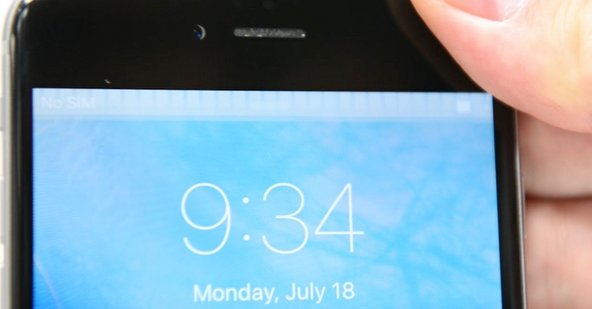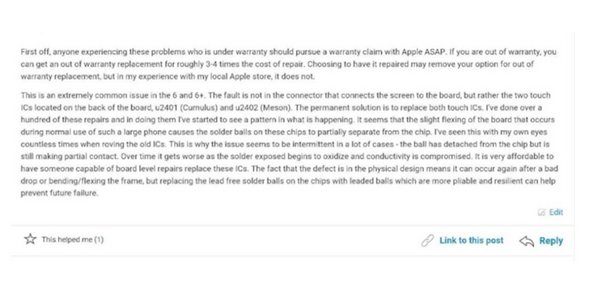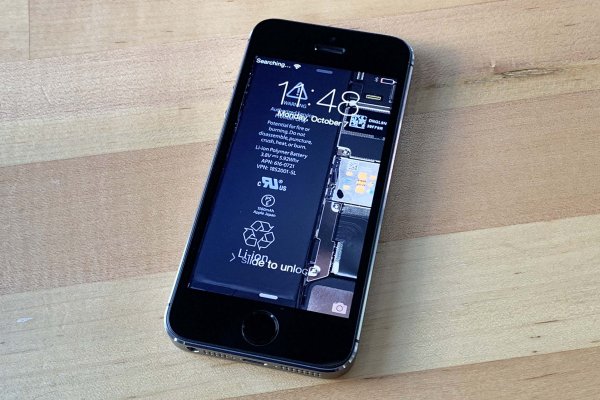People all over the world mail their broken iPhones to microsoldering specialist Jessa Jones. Aided by powerful microscopes and precision soldering irons, experts like Jessa pluck tiny chips off logic boards, swap them for new ones, and resurrect devices over which Apple’s Genius Bar would say a eulogy.
Jessa can fix practically anything. But these days, she spends most of her time fixing just one thing. Because every single month, more and more iPhone 6 and (especially) 6 Plus devices show up at her shop, iPad Rehab, with the same problem: a gray, flickering bar at the top of the display and an unresponsive touchscreen.

Turns out, Jessa’s not alone. Lots of repair pros are experiencing the same influx of faulty iPhones—most with flickering gray bars and all with glitchy touch functionality. Rami Odeh, a repair tech from New Orleans, sees up to 100 iPhone 6 and 6 Pluses a month that don’t respond well to touch. About half of the repairs sent to Michael Huie—the specialist behind Microsoldering.com—show symptoms of the same problem.
Of course, there’s no way to tell exactly how many phones are afflicted with what we’re calling Touch Disease, but every repair tech we spoke to told us that the problem is incredibly common.
“This issue is widespread enough that I feel like almost every iPhone 6/6+ has a touch of it (no pun intended) and are like ticking bombs just waiting to act up,” says Jason Villmer, owner of STS Telecom—a board repair shop in Missouri. He sees phones like this several times a week.
If pages and pages of complaints on Apple’s support forum are any indication, Apple’s aware there’s a hardware issue with the iPhone 6 and 6 Plus—but they aren’t doing anything about it.
“I took [my phone] to the ‘Geniuses’ at Apple Store in Westfield Valley Fair mall (Santa Clara, CA),” one iPhone 6 Plus owner wrote on Apple’s support forum. “After a very long wait (~2 hrs) I finally met with a rep. He acknowledged the problem (he was very familiar with it), but said Apple doesn’t recognize it as an issue, and so there is not much he can do.” Another iPhone 6 Plus owner was apparently told by an Apple employee that people come in with this issue “several times per day.” “After talking to a tech, I got exactly what I expected ‘You’re out of warranty and you’re [sic] only option is to buy a new phone,” the user wrote.
Despite Apple’s white flag, some afflicted users have noticed that strategically twisting the phone a bit or putting pressure on the screen reverses the issue for a while. The gray flickering bar goes away. After a short remission, though, the iPhone illness gets worse. The insidious gray bar of death spreads. Touch functionality gets increasingly glitchier. Eventually, the phone loses touch completely.
Touch Disease Goes Deeper than the Screen
Here’s where the plot thickens: Replacing the touchscreen doesn’t fix the problem. The gray bar eventually shows up on the new screen, too. Because, according to repair pros, the problem isn’t the screen at all. It’s the two touchscreen controller chips, or Touch IC chips, on the logic board inside the phone.

These two chips translate your finger mashing on the display into information your phone can actually use. When the Touch IC chips go bad, you can jab, tap, and poke the screen all you want—your phone can’t correctly process the information. At least, not until the bum chips are replaced with new ones.
Apple’s repair Geniuses aren’t equipped to make specialized repairs to the logic board in-house, so they can’t actually fix Touch Disease. But skilled, third-party microsoldering specialists (most “unauthorized” to do Apple repairs, according to official company policy) can fix phones with symptoms of Touch Disease. And they can do it a whole lot cheaper than the cost of a new logic board or an out-of-warranty phone replacement. Which is precisely why so many of these damaged iPhones are finding their way into repair shops around the world.
“The issue is ridiculously widespread and Apple should’ve issued a recall or maybe a free warranty repair on this problem already,” Huie told me via email. “If you own an iPhone 6+ and haven’t experienced the problem yet, then I think the chances are pretty high that you’ll experience it during the lifetime of the phone.”
Bendgate 2.0: The Crackening
After fixing hundreds of broken iPhone 6 and 6 Pluses, many pros have developed theories about what causes Touch Disease in these two specific models. One microsoldering pro I spoke to speculated that the U2402 Meson chip—one of the two Touch IC chips on the board—has a manufacturing defect. But the most popular theory I heard is that Touch Disease is the unanticipated, long-term consequence of a structural design flaw: Bendgate.
Back when the iPhone 6 and 6 Plus were first released, some owners discovered that the large, wide phones had a nasty habit of molding themselves to the shape of your rump if left too long in a back pocket. The phenomenon, known as Bendgate, was ostensibly put to bed when Apple apparently strengthened weak points in the rear case of the iPhone 6s.
“But the fact remains—compared to earlier iPhone models, the iPhone 6/6+ is kind of a ‘bendy’ phone. Its slim form factor and larger surface area subject the logic board within the phone to mechanical flexion pressure that no other iPhone has had to deal with,” Jessa explains in a detailed blog post. The iPhone 6 Plus—the wider of the two phones—appears to be especially susceptible to this kind of damage.
In both the iPhone 6 and 6 Plus, the Touch IC chips connect to the logic board via an array of itty-bitty solder balls—“like a plate resting on marbles,” Jessa explains. Over time, as the phone flexes or twists slightly during normal use, those solder balls crack and start to lose contact with the board.
“At first, there may be no defect at all. Later you might notice that the screen is sometimes unresponsive, but it is quick to come back with a hard reset,” Jessa explains. “As the crack deepens into a full separation of the chip-board bond, the periods of no touch function become more frequent.” Any drops or heavy handling keep chipping away at the cracked solder balls. Damage enough of them, and the connections between the chips and the logic board are severed, signals are lost, touch gets glitchier, and then goes away altogether.
Size Matters—But the Devil’s in the Details
Of course, the iPhone 6s and 6s Plus are also big phones—so why doesn’t Touch Disease happen to them, too? It turns out that size matters—but it’s not the only thing that matters. In the iPhone 6s/6s Plus, Apple moved the susceptible Touch IC chips off the logic board and onto the display assembly, presumably sheltering them from most of the flexing forces the logic board is subjected to.
And repair professionals have singled out other problematic design elements of the iPhone 6 and 6 Plus. In other phones, a little blob of cured “underfill” beneath critical chips helps to keep solder balls secure—but there’s no underfill anchoring Touch IC chips to the board in the iPhone 6 and 6 Plus. In previous iPhone models, Apple also covered the Touch IC chips with a rigid, metal EMI shield. In the iPhone 6 and 6 Plus, the rigid shield was replaced with a pliable sticker shield.
“Since the Touch IC chip doesn’t have underfill, nor a metal backing, it seems to be the first to ‘break off’ the logic board,” Huie explains. “When I say ‘break off,’ I mean the solder joints break off from the chip, which causes the no touch.”
How Do You Fix Touch Disease?
So what do you do if you see a gray, flickering bar at the top of your iPhone 6 or iPhone 6 Plus? That twisting trick we mentioned earlier? Turns out putting pressure on the screen allows the chip to make full contact with the board again, Jessa explained. But it’s not a permanent fix. It’s a bandaid—and a poor one, at that (don’t break your phone trying to fix it, please). The only permanent fix is to replace the phone (expensive), replace the logic board (also expensive), or replace both Touch ICs on the board (less expensive).
Watch our interview with Jessa to learn more:
So, if you’re experiencing symptoms of Touch Disease and you’re still in warranty—now might be a good time to take advantage of that warranty replacement option. Though, there’s no guarantee that your replacement phone won’t suffer from the same issue somewhere down the line, too.
If you’re out of warranty, you can take your phone to an electronics repair shop that offers board-level repairs. A good microsolderer can replace those two Touch IC chips on the iPhone’s logic board for less than the price of a new phone. (Make sure the shop you choose replaces the chips, and doesn’t just reflow them, warns Jessa. Reflowing—or heating up the chips until the solder melts and reconnects to the joint—doesn’t fix the loss of touch in the long run. The problem tends to come back.)
In order to ensure that Touch Disease is actually cured, some repair shops have been experimenting with ways to keep the logic board from flexing. After a Touch IC repair, iPad Rehab, for example, has been adding a strong metal shield over the top of the chips as an internal reinforcement.
“We have found that placing our own mod—a metal shield soldered over the sticker shield—seems to protect the phone from future recurrence of the problem. We (and others) have only recently started sending out our Touch IC jobs with the ‘futureproof’ shield on them,” Jessa says. So far, she says, none of her customers have reported any adverse effects from the hardware mod.
Of course, no option involving independent repair would be endorsed by Apple. In fact, Jessa and colleague Mark Shaffer have been censored and banned from posting on Apple Support Communities for explaining why touch fails and suggesting third-party repair as a solution.


So it seems like Apple is happy to sell people replacement phones, but they seem unwilling to point iPhone owners to the only people who can actually fix the problem: independent repair shops.
“[Apple doesn’t] tell customers they can get it fixed at an independent service center. They don’t offer repair of it at all. The only option that Apple offers to people who encounter this problem is ‘Would you like to buy a new iPhone?” says Louis Rossmann—a board repair expert from New York City—in a YouTube video on the topic.
Rossmann predicts that, eventually, the Touch Disease problem will probably explode into a class action lawsuit—at which point Apple will be forced to respond with some sort of extended warranty program. But only if customers start banding together and demanding more support from Apple for this problem.
If you’ll remember, it took an exposé and a massive public outcry for Apple to address Error 53—and that was a comparatively easy-to-fix software issue. Touch Disease is a hardware problem; Apple can’t fix this thing with an iOS update. Addressing Touch Disease is going to be more complicated, and more costly. But if the issue is as widespread as repair pros suspect, then Apple should start offering customers solutions instead of excuses. And they need to do it soon.
“Apple has designed phones better than this in the past. They need to design phones better than this in the future,” says Rossmann. “And they need to take accountability and responsibility for the devices that people have been paying for right now that don’t work the way they’re supposed to.”




5 Comments
My iPhone 6 Plus came new to me Dec.2015 and still healthy and heavy every day usage, never got any screen or any other problems? Now it’s Sep.2019
so this broken chip is not every phone right?
TheRIDE - Reply
It finally makes sense. In a former life, I was the precision microsoldering expert. The solder balls DO fail, and it’s because partly due to the lead-free balls that they/everyone uses. Leaded balls would absolutely solve this issue. More flexible and better flow even without a stiffening mod.
Thanks! My iPhone 6S is getting an upgrade! I wonder if the 7 has this issue…..?
dean waltman - Reply
Shame on Applethat they deliberatly denied anything. This was a design fault and Apple WAS resonsible.
Goetz - Reply
Export SMS from iPhone using SMS Backup iPhone software in an easy and safest way without losing all your precious messages. Using our iPhone SMS backup software, you can backup SMS, MMS, iMessage, and recover deleted iPhone messages to your computer.
ashwini ash - Reply
i I have now bandaid fixed 2 iphone 6 phones with touch disease using the electrical tape pressure hack and both are functioning just fine over time.
dnonen - Reply